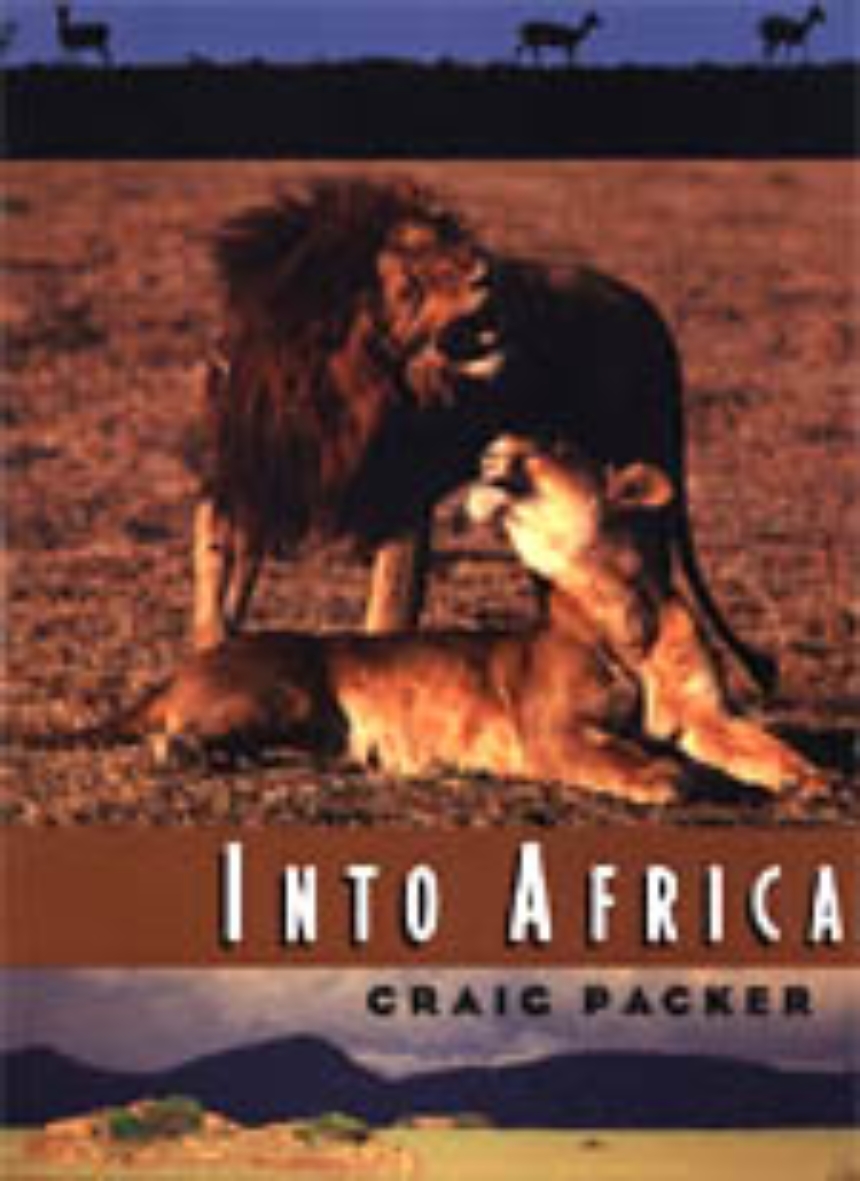Into Africa
Craig Packer takes us into Africa for a journey of fifty-two days in the fall of 1991. But this is more than a tour of magnificent animals in an exotic, faraway place. A field biologist since 1972, Packer began his work studying primates at Gombe and then the lions of the Serengeti and the Ngorongoro Crater with his wife and colleague Anne Pusey. Here, he introduces us to the real world of fieldwork—initiating assistants to lion research in the Serengeti, helping a doctoral student collect data, collaborating with Jane Goodall on primate research.
As in the works of George Schaller and Cynthia Moss, Packer transports us to life in the field. He is addicted to this land—to the beauty of a male lion striding across the Serengeti plains, to the calls of a baboon troop through the rain forests of Gombe—and to understanding the animals that inhabit it. Through his vivid narration, we feel the dust and the bumps of the Arusha Road, smell the rosemary in the air at lunchtime on a Serengeti verandah, and hear the lyrics of the Grateful Dead playing off bootlegged tapes.
Into Africa also explores the social lives of the animals and the threats to their survival. Packer grapples with questions he has passionately tried to answer for more than two decades. Why do female lions raise their young in crèches? Why do male baboons move from troop to troop while male chimps band together? How can humans and animals continue to coexist in a world of diminishing resources? Immediate demands—logistical nightmares, political upheavals, physical exhaustion—yield to the larger inescapable issues of the interdependence of the land, the animals, and the people who inhabit it.
As in the works of George Schaller and Cynthia Moss, Packer transports us to life in the field. He is addicted to this land—to the beauty of a male lion striding across the Serengeti plains, to the calls of a baboon troop through the rain forests of Gombe—and to understanding the animals that inhabit it. Through his vivid narration, we feel the dust and the bumps of the Arusha Road, smell the rosemary in the air at lunchtime on a Serengeti verandah, and hear the lyrics of the Grateful Dead playing off bootlegged tapes.
Into Africa also explores the social lives of the animals and the threats to their survival. Packer grapples with questions he has passionately tried to answer for more than two decades. Why do female lions raise their young in crèches? Why do male baboons move from troop to troop while male chimps band together? How can humans and animals continue to coexist in a world of diminishing resources? Immediate demands—logistical nightmares, political upheavals, physical exhaustion—yield to the larger inescapable issues of the interdependence of the land, the animals, and the people who inhabit it.
292 pages | 13 color plates, 4 maps | 6 x 8 | © 1994
Biological Sciences: Behavioral Biology, Natural History
Travel and Tourism: Travel Writing and Guides
Reviews
Table of Contents
Part I - Lion Eyes
Minneapolis
Saturday, 26 October
London
Sunday, 27 October
Nairobi
Monday, 28 October
Tuesday, 29 October
Wednesday, 30 October
Arusha
Thursday, 31 October
Friday, 1 November
Ngorongoro
Saturday, 2 November
Serengeti
Sunday, 3 November
Monday, 4 November
Tuesday, 5 November
Wednesday, 6 November
Thursday, 7 November
Friday, 8 November
Saturday, 9 November
Sunday, 10 November
Monday, 11 November
Arusha
Tuesday, 12 November
Part II - Dark Star
Dar es Salaam
Wednesday, 13 November
Thursday, 14 November
Friday, 15 November
Gombe
Saturday, 16 November
Sunday, 17 November
Monday, 18 November
Tuesday, 19 November
Wednesday, 20 November
Thursday, 21 November
Friday, 22 November
Saturday, 23 November
Sunday, 24 November
Monday, 25 November
Kigoma
Tuesday, 26 November
Dar es Salaam
Wednesday, 27 November
Mto-wa-Mbu
Thursday, 28 November
Part III - Red Rover
Ngorongoro
Friday, 29 November
Saturday, 30 November
Sunday, 1 December
Monday, 2 December
Tuesday, 3 December
Wednesday, 4 December
Serengeti
Thursday, 5 December
Friday, 6 December
Saturday, 7 December
Sunday, 8 December
Monday, 9 December
Tuesday, 10 December
Wednesday, 11 December
Thursday, 12 December
Friday, 13 December
Nairobi
Saturday, 14 December
Sunday, 15 December
London
Monday, 16 December
Postscript
Minneapolis, March 1996
Acknowledgments
Credits
Maps
East Africa
Serengeti National Park
Gombe National Park
Ngorongoro Crater
Minneapolis
Saturday, 26 October
London
Sunday, 27 October
Nairobi
Monday, 28 October
Tuesday, 29 October
Wednesday, 30 October
Arusha
Thursday, 31 October
Friday, 1 November
Ngorongoro
Saturday, 2 November
Serengeti
Sunday, 3 November
Monday, 4 November
Tuesday, 5 November
Wednesday, 6 November
Thursday, 7 November
Friday, 8 November
Saturday, 9 November
Sunday, 10 November
Monday, 11 November
Arusha
Tuesday, 12 November
Part II - Dark Star
Dar es Salaam
Wednesday, 13 November
Thursday, 14 November
Friday, 15 November
Gombe
Saturday, 16 November
Sunday, 17 November
Monday, 18 November
Tuesday, 19 November
Wednesday, 20 November
Thursday, 21 November
Friday, 22 November
Saturday, 23 November
Sunday, 24 November
Monday, 25 November
Kigoma
Tuesday, 26 November
Dar es Salaam
Wednesday, 27 November
Mto-wa-Mbu
Thursday, 28 November
Part III - Red Rover
Ngorongoro
Friday, 29 November
Saturday, 30 November
Sunday, 1 December
Monday, 2 December
Tuesday, 3 December
Wednesday, 4 December
Serengeti
Thursday, 5 December
Friday, 6 December
Saturday, 7 December
Sunday, 8 December
Monday, 9 December
Tuesday, 10 December
Wednesday, 11 December
Thursday, 12 December
Friday, 13 December
Nairobi
Saturday, 14 December
Sunday, 15 December
London
Monday, 16 December
Postscript
Minneapolis, March 1996
Acknowledgments
Credits
Maps
East Africa
Serengeti National Park
Gombe National Park
Ngorongoro Crater
